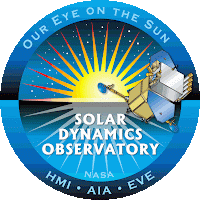jeudi 2 janvier 2014
Two Solar Flares Say Goodbye 2013 and Welcome 2014
NASA - Solar Dynamics Observatory patch.
Jan. 2, 2014
Image above: Several wavelengths of light are combined in this New Year's Day solar flare image, categorized as an M9.9 and peaking at 1:52 p.m. EST on Jan. 1, 2014. Each wavelength represents material at a different temperatures, helping scientists understand how it is moved and heated through these events. Image Credit: NASA/SDO.
The sun ushered out 2013 and welcomed 2014 with two mid-level flares on Dec. 31, 2013 and Jan. 1, 2014. Solar flares are powerful bursts of radiation. Harmful radiation from a flare cannot pass through Earth's atmosphere to physically affect humans on the ground, however -- when intense enough -- they can disturb the atmosphere in the layer where GPS and communications signals travel. This disrupts the radio signals for as long as the flare is ongoing, anywhere from minutes to hours.
Image above: This image was captured on Jan. 2, 2014, by NASA’s Solar Dynamics Observatory’s Helioseismic and Magnetic Imager, or HMI, instrument, designed to study the magnetic field at the solar surface, or photosphere. Image Credit: NASA/SDO/HMI.
To see how this event may impact Earth, please visit NOAA's Space Weather Prediction Center at http://spaceweather.gov, the U.S. government's official source for space weather forecasts, alerts, watches and warnings.
The first flare (below) was categorized as an M6.4 and it peaked at 4:58 p.m EST on Dec. 31. The second (above) was categorized as an M9.9 and peaked at 1:52 p.m. EST on Jan. 1. Both flares emerged from the same active region on the sun, AR1936.
Image above: An M6.4 class solar flare erupts from the sun in this image from NASA's Solar Dynamics Observatory, which was captured on Dec. 31, at 4:59 p.m. EST. The image shows light in the 304 Angstrom wavelength, which is typically colorized in red. Image Credit: NASA/SDO.
Imagery of the flares was captured by NASA's Solar Dynamics Observatory, which keeps a constant watch on the sun, collecting new data every 12 seconds.
Updates will be provided as needed.
Related Links:
Frequently Asked Questions Regarding Space Weather: http://www.nasa.gov/mission_pages/sunearth/spaceweather/index.html
View Other Past Solar Activity: http://www.nasa.gov/mission_pages/sunearth/multimedia/Solar-Events.html
Images (mentioned), Text, Credit: NASA's Goddard Space Flight Center / Karen C. Fox.
Greetings, Orbiter.ch




